#hieron ii
Explore tagged Tumblr posts
Text
Coin of the Day #172 (10/23/2024)
A very old Sicilian coin…
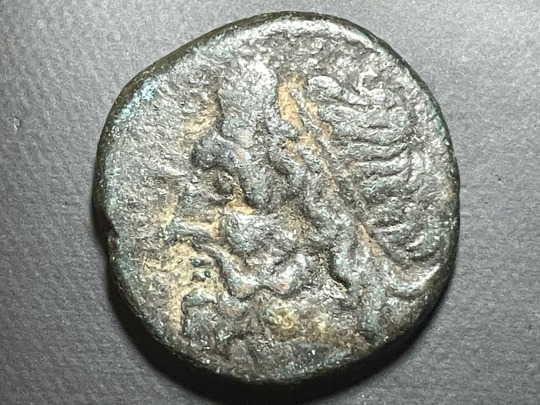
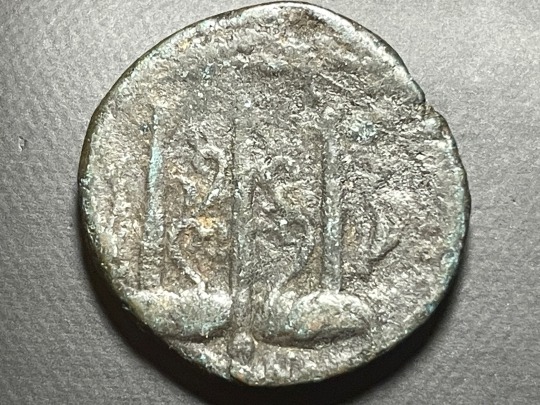
Sicily
AE19 - 5.52g
Hieron II 275-215 BC
Syracuse Mint
Obverse Head of Poseidon left, diademed
Reverse IEPΩNOΣ
Ornamented trident flanked by dolphins
#coin of the day#ancient greece#sicily#syracuse#hieron ii#greek coins#coin#coins#numismatics#ancient coins
4 notes
·
View notes
Photo


~ Drachm of Syracuse with the head of Persephone, struck under Hieron II. Culture: Greek Period: Hellenistic Date: 274–216 B.C. Mint: Sicily, Syracuse Medium: Gold
#ancient#ancient currency#ancient coin#numismatics#drachm of syracuse#persephone#hieron ii#gold#sicily#hellenistic#greek#274 b.c.#216 b.c.
402 notes
·
View notes
Photo








Altar of Hieron (Great Altar of Syracuse)
Syracuse, Sicily
3rd century BCE
195.8 m. in length (!!!)
It was built in the Hellenistic period by King Hiero II and is the largest altar known from antiquity.
The structure is aligned roughly north-north-west to south-east-east, and is located in the Neapolis, slightly to the southeast of the Greek theatre. Almost nothing except the foundations of the structure survive today. The structure was partly built from masonry blocks and partially carved from the living bedrock. The altar itself is 20.85 metres wide and 195.8 metres long (exactly one Doric stade). It sits on a crepidoma with three steps - at base this is 199.07 metres long and 22.51 metres wide. This makes it the largest altar known from the ancient world.
The upper surface of the altar was divided lengthwise into two levels of different heights: the western half was perhaps 6.06 metres high, and the eastern half was significantly taller, rising to a height of perhaps 10.68 metres. There was a cornice and a Doric triglyph frieze running around the top of each level. The whole structure was covered in plaster, which was used to smooth out imperfections in the stone and for the fine decorative details. The overall structure of the altar mimics that of small fire altars which are common votive offerings in Sicily.
There were stairways on the eastern side of the altar at the northern and southern ends, which led up to the lower level of the structure. Each of the staircases had an entranceway which was supported by two telamones. The feet of one of the norther one telamones are still in situ. It is unclear whether it was possible to access the higher level of the structure.
The altar was part of a larger complex. Below the structure, on the eastern side, there was a natural grotto, about 18 metres deep which contained votive offerings, some of which were deposited in the Archaic and Classical periods, long before the altar was built. To the west of the altar there was a rectangular open space with a water-proofed basin in the centre, surrounded by a u-shaped stoa. A propylon on the western side of this compound allowed access to both the open space and thus to the altar itself. In Augustan times, this open space was planted with trees in order to turn it into a sacred grove.
#art#Architecture#travel#history#greek#Greek architecture#Greek Mythology#zeus#altar#hiero#hiero II#hieron#sicily#italy#syracuse#3 bce#telamon#statue#doric
667 notes
·
View notes
Photo

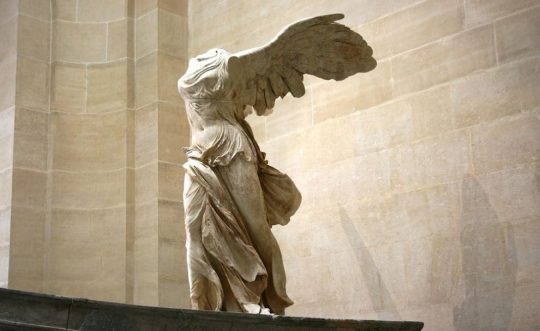
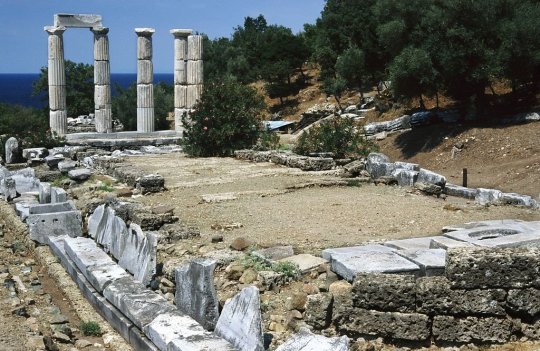
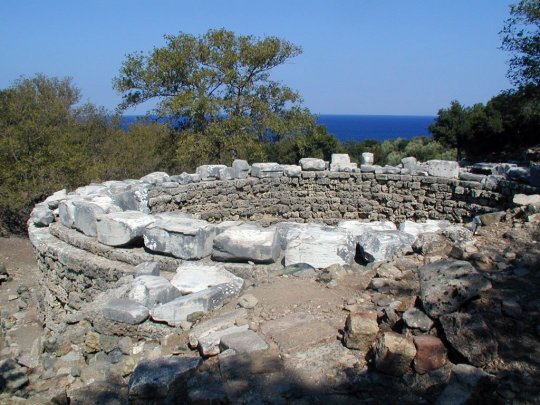
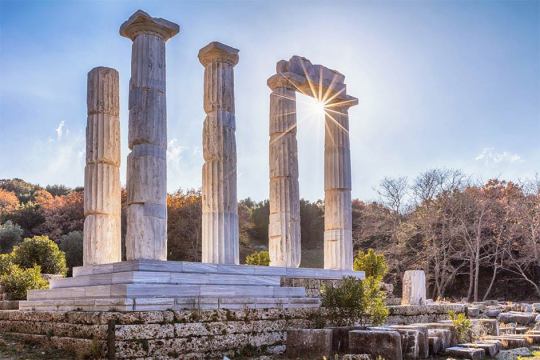
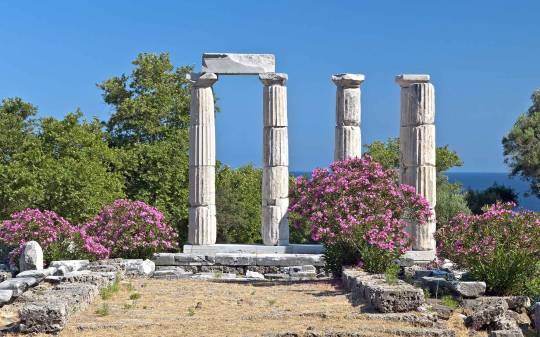
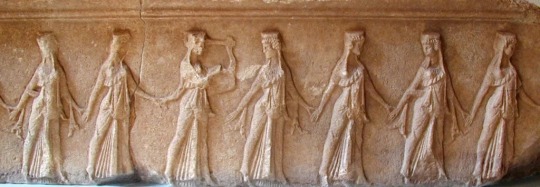
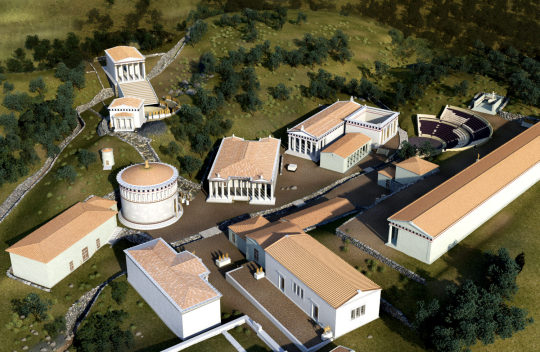

The Ancient Greek Sanctuary of Samothrace
Samothrace, a small, rocky Greek island in the northern Aegean Sea, has a storied past that belies its diminutive size. One of the most rugged of all the Greek islands, its Mt. Saos rises to 1,611 meters (5,285 feet).
Known best for its Sanctuary of the Great Gods, or Hieron ton Megalon Theon, in Paleopolis, it was once the home of the stunningly beautiful 2.5-meter (8.2-foot) tall marble statue of Nike, created in 190 BC, now known as the “Winged Victory of Samothrace.”
Like so many other of Greece’s ancient treasures, it now is displayed in a European museum (in this case, the Louvre in Paris); but it was once part of the Sanctuary, whose remains still grace the island today.
Found in pieces in the ground by the French archaeologist Charles Champoiseau, the sculpture is recognized universally as one of the most arrestingly beautiful in all the world.
The ancient city on Samothrace, the ruins of which are called Palaeopolis (“old city”), was situated on the north coast of the island. Much of its ancient walls, which were built in massive Cyclopean style, are still extant.
Traditional accounts from antiquity state that the island of Samothrace was first inhabited by Pelasgians and Carians, and later Thracians. At the end of the 8th century BC the island was believed to have been colonized by Greeks from Samos, hence the name Samos of Thrace, which later became Samothrace.
The Samothrace Temple Complex served as one of the major pan-Hellenic religious sanctuaries; it was also a center for its own mystery religion which was open to the worship of all, not just a select few initiates.
The temple complex, which was visited by a panoply of notable figures from the past, including Lucius Calpurnius Piso Caesoninus, the father-in-law of Julius Caesar, was mentioned by Plato and Aristophanes.
The cult of the mysterious, unnamed “Great Gods” on Samothrace
During the Hellenistic period, after the investiture of Phillip II, it formed a Macedonian national sanctuary. It remained an important religious site throughout the Roman period, with the Emperor Hadrian visiting Samothrace at one point during his reign.
Samothrace still has some of its ancient mysteries intact, with historians still trying to discover the identity and nature of the deities venerated at the sanctuary. This is in large part because it was taboo to even pronounce their names in ancient times.
Literary sources from antiquity refer to them under the collective name of “Κάβειροι,” or Kábiroi), while they are also known by the simpler epithet of “Great Gods.”
The Pantheon of the Great Gods at Samothrace consists of numerous chthonic deities, meaning those having to do with the underworld. This incredibly even predated the arrival of Greek colonists on the island in the 7th century BC.
Earth Mother deity central at Samothrace
The Earth Mother, or Great Mother, a goddess often depicted on Samothracian coinage as a seated woman, with a lion at her side, was the central deity at the sanctuary. Fortunately, her secret name, Axiéros, is known to us today. The Greeks associated her with the goddess of fertility, Demeter.
Hecate, under the name of Zerynthia, and Aphrodite-Zerynthia, two important nature goddesses, are equally venerated at Samothrace, although their cult was distanced from that of the Great Mother and more closely identified with deities more familiar to the Greeks, according to historians.
Kadmilos (Καδμίλος), the spouse of Axiéros, is a fertility god identified by the Greeks as Hermes; he was a phallic deity whose sacred symbols were a ram’s head and a baton (kerykeion), which can even be found on some currency.
Two other male deities accompany Kadmilos; these may be the two mythical heroes who are credited with founding founded the Samothracean mysteries: the brothers Dardanos (Δάρδανος) and Iasion (Ηετίων). They were associated by the Greek people of the time with the Dioscuri, the divine twins who were known as protectors of mariners in distress.
Mariners navigating around Samothrace left offerings to the gods
And that would be fitting, since ancient Greek mariners were known to leave offerings at the site of the sanctuary on Samothrace in order to secure their safe passage around the rocky island.
The sanctuary was open to everyone who wished to worship the Great Gods, unlike other sanctuaries in ancient Greece, which would only be opened to certain initiates. The rituals and ceremonies at Samothrace were presided over by the priestess; its head priestess, who was often a prophetess, had the title of “Sybil,” or “Cybele.”
Prayers and supplications at the sanctuary would be accompanied by blood sacrifices of domestic animals, including sheep and pigs, whose carcasses were burned in sacred hearths, as well as libations made to the deities.
Many altars made of rock were used for these purposes, the largest of which was surrounded by a monumental enclosure at the end of the 4th century BC.
The major annual festival on Samothrace, which drew envoys to the island from throughout the Greek world, most likely took place in mid-July. Consisting of the presentation of a sacred play, which entailed a ritual wedding, this may have taken place in the building with the Dancer’s Wall, which was built in the 4th century BC.
Around the year 200 BC, a Dionysian competition was added to the festival, facilitated by the construction of a theater in the complex.
Many votive offerings were made at the sanctuary, which were placed in a building made for that purpose next to the great altar; typical offerings could have been statues of bronze, marble or clay, as well as weapons or vases.
The first stage of the initiation rites into the Samothracian mysteries was the “myesis.” A sacred story and special symbols were revealed to the initiate; during the ceremony he or she would receive a crimson sash tied around the waist which was meant to be a protective talisman.
An iron ring exposed to the divine power of magnetic stones on the island was most likely another symbol of protection conferred during the initiation, archeologists believe.
The sanctuary on Samothrace consists of three narrow terraces on the west slopes of Mount Hagios Georgios, separated by two steep-banked streams. The entrance is through the Ptolemy II propylaeum, also known as the Ptolemaion, which spans the eastern brook like a bridge.
A winding path then descends towards the main terrace, sited between two brooks, where the main monuments of the sanctuary are found. A large tholos, the Arsinoëion, or Arsinoë Rotunda, is the largest covered round space in the ancient Greek world.
Measuring an incredible 20 meters (65 feet) in diameter, it may have served to welcome the theoroi, the sacred ambassadors sent by cities and associations to attend the great festivals at the sanctuary.
Building of the Dancers Frieze marks even more ancient sacrificial area
The Building of the Dancer’s Frieze, the largest at the Sanctuary, constructed on an even older sacrificial area, is located at the opening of the path leading to the site.
The most important building of the cult, the Epopteion, is located to the south of the Temenos. This building bears the inscription of Hieron. The interior boasts the largest unsupported span in the ancient Greek world – 11 meters (36 feet).
The Anaktoron, the building for greeting the religious initiates, is located north of the Arsinoë Rotunda.
The third and final terrace, west of the spiritual center of the sanctuary, is primarily occupied by buildings for offerings, such as the Miletean Building, dedicated by a citizen of Miletus, and the Neorion, or naval monument. It is also the location of what as once a banquet hall.
The space above all of these buildings is dominated by an enormous portico measuring an astounding 104 meters (341 feet) long; this acts as a monumental backdrop to the entire sanctuary.
The remains of a square Byzantine fort is also in this area; it was constructed of re-used building material from the original site.
Strong ties to Macedonia, Philip II and his wife Olympias
The historian Plutarch, in his work “Life of Alexander,” says that Philip of Macedon, later to become the father of Alexander the Great, was initiated into the mysteries of Samothrace at the same time as Olympias; he immediately fell in love with her and betrothed himself to her at once.
The first sovereign of whom epigraphic traces remain was the son of Philip II and half-brother of Alexander, Philip III of Macedon, who would become the principal benefactor of the Sanctuary during the 4th century BC.
The second surge of major construction started in the 280’s BC with the building of the Arsinoe II Rotunda, which may date from 288–281 BC, when this daughter of Ptolemy I was married to the Diadochi Lysimachus, who was then king of Macedon.
Philip V of Macedon, the last Antigonid king to attempt to establish a Macedonian thalassocracy, or seaborne empire, had a monumental column dedicated to him in front to the large stoa of the upper terrace by the Macedonians by the year 200 BC.
“Winged Victory” statue created around 200 BC
Historians believe that it was probably during one of these episodes that the monumental fountain containing a ship’s prow of limestone — and the masterpiece of the Winged Victory of Samothrace statue — were created.
During the Roman and particularly the imperial period, thanks to the interest of the Roman emperors, Samothrace became an international religious center, where pilgrims flocked from all over the Roman world.
The island is mentioned in the Bible, with the name Samothracia; the Book of Acts records that the Apostle Paul, on his second missionary journey, sailed from Troas to Samothrace and spent one night there on his way to Macedonia.
The Ottoman Empire conquered the island in 1457. An insurrection against them by the local population during the Greek War of Independence (1821–1831) led to the wholesale massacre of 1,000 Samothracians.
Excavations of sanctuary continue down to present time
Following the 1863 discovery of the Winged Victory, by French consul Charles Champoiseau, who was based out of Adrianople, the French team of Deville and Coquart carried out the first archeological excavation of Samothrace three years later, in 1866.
Austrian archaeologists were the next on the scene, uncovering the Ptolémaion and the stoa in 1873 and 1876; they also carried out some superficial excavations of the Hiéron and the Arsinoéion as well as the Temenos.
As part of an agreement they signed with the Ottomans, the Austrians divided what would now be considered the plunder of the site between Vienna’s Kunsthistorisch Museum, museums in Gallipoli and the Istanbul Archeological Museum.
And, as always seemed to happen in Greek discoveries, some of the objects disappeared on the way to these institutions — never to appear again publicly.
Champoiseau returned to Samothrace in 1891 to search for the blocks which formed the ship’s prow upon which the Winged Victory statue had been installed in Paris; while there he discovered the theater that had been constructed in 200 BC as part of the Dionysian competition.
The Institute of Fine Arts of New York University started its first excavations in 1938, as a result of which which the Anaktoron was unearthed. Interrupted by World War II, during which time the site suffered greatly as a result of Bulgarian occupation, they returned to Samothrace in 1948; their excavations continue to the present day.
By Patricia Claus.
#The Ancient Greek Sanctuary of Samothrace#statue#statue of Nike#winged victory of samothrace#archeology#archeolgst#ancient artifacts#history#history news#ancient history#ancient culture#ancient civilizations#ancient greece#greek history#roman history#long reads
137 notes
·
View notes
Text
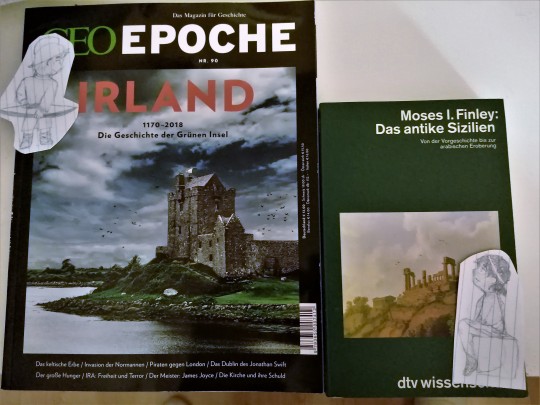
I'm here in search of your glory There's been a million before me That ultra-kind of love You never walk away from You're just the last of the real ones
I've recently put my money where my mouth is & bought books and magazines to learn more about my favourite isles on the planet. Of course I couldn't help myself & had to draw my Hetalia OCs, Ireland and Sicily, staring fondly and full of curiosity at each other throughout time and space.
Close-Ups underneath the cut!
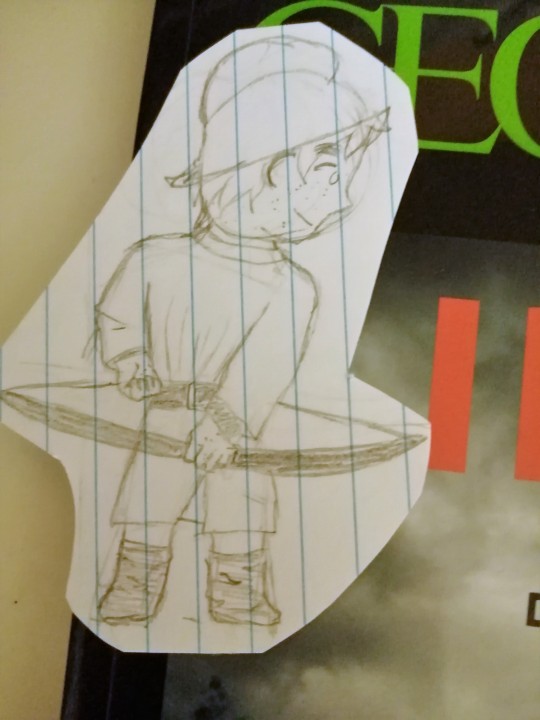

Ireland - Or Harry/Liam O'Connel - is supposed to represent a 16th century clansman & pirate! I used the illustrations from the magazine's article on Gráinne O'Malley as reference. If you don't know who Gráinne O'Malley is, go and listen to this wonderful podcast on her. She was an Irish noblewoman who made a living partially by extorting taxes out of any ships passing her part of the coast and raiding other settlements on the island. And she was a major pain in the neck of the English administration, who wanted to weed out any source of resistance against their rule!
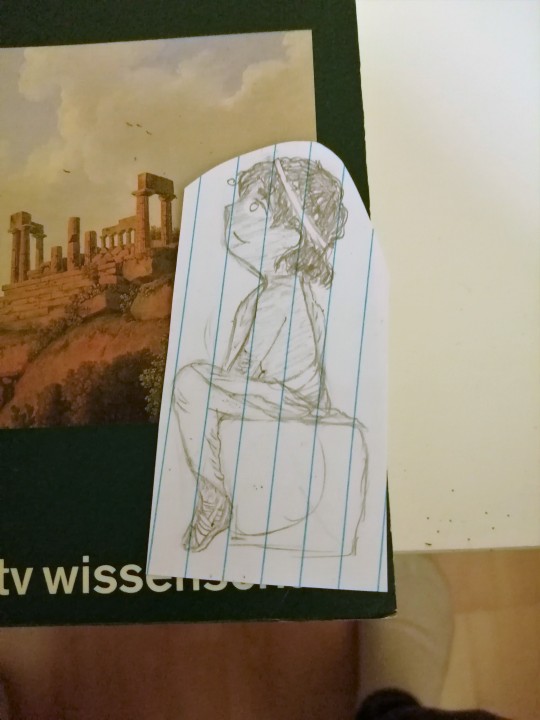
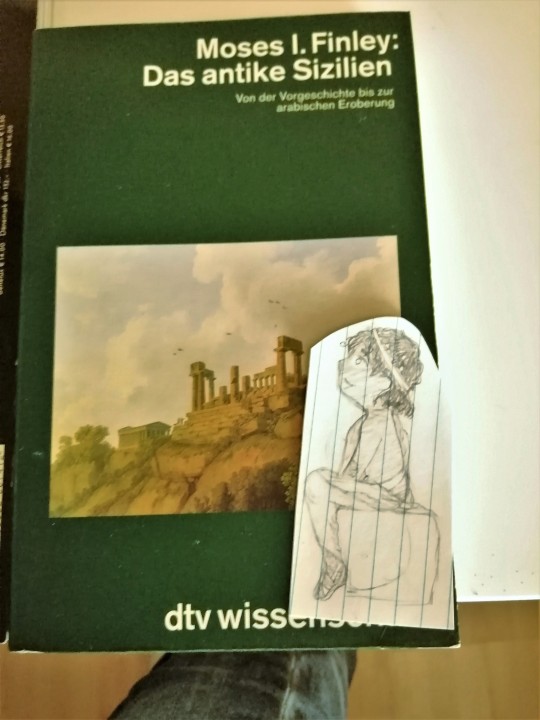
Sicily - Or Michele Vento - is clad in a Himation and wearing a hairband or crown: He's supposed to represent Hieron II, a tyrant of Syracuse who brought his city a lot of splendour and stable, politic times due to diplomatic foresight. Switching sides quickly from Carthage to Rome during the second punic war, he ensure his city one last era of prosperity before it should fall into political turmoil under his grandson Hieronymus and at last be sacked by the Romans. His appearance is both based on coins issued by Hieron II, depicting his head, and a statue of a hellenistic ruler, published in Griechische Kleidung by Margarete Bieber, first published in 1928.
#aph#hetalia#hetalia ocs#hws#hws ireland#aph ireland#hws sicily#aph sicily#historical hetalia#storie nostre#harry#miche#sicire#my art
15 notes
·
View notes
Text
Friendly reminder Louis is performing here in 30 days.



Now since I’m a geek, let me rant about some ancient history and… 🥁 🥁 mythology! It never happens that international artists come to the South. This is huuuuuge for me and I am very proud (I don’t live in Sicily, I’m the friendly neighbour i guess, but I love it!).
Anyway.
The building dates back to III century b.C. Presumably the theater is of Hellenistic origin, as suggested by some stone blocks from Taormina and the inscriptions in Greek on some steps with the name of Philistis, wife of Hieron II and probable commissioner of the building, preserved in the western versure.
It was rebuild by the Emperor Augustus in the II a.C. and they used it for venationes, spectacles including gladiators fights against ferocious beasts. It was partially destroyed by the Vandals and later abandoned after the end of the roman empire.
The Theater has once again become a true protagonist with the romantic rediscovery linked to the Grand Tour. Starting from the XVII century, Taormina and above all its theater represent a must for every traveler who is passionate about history and culture. In 1978, Goethe visited the theatre and wrote a cute rec in one of his letters, describing the Theatre sublime for the decadency and the breathtaking view.
The viewpoints that the theater offers allow you to admire Etna Volcano and the bay of Naxos and Taormina to the south or the Calabrian coast with the Strait of Messina to the north. A spectacular natural setting. The scene partly retains its original form, thanks to a controversial nineteenth-century restoration. Two large side rooms (versurae) closed the stage and the stalls. Consisting of the steps, the auditorium has a diameter of 109 meters. It is subdivided into nine sectors or "wedges" by eight ladders and could hold at least 10,000 spectators (today 4,500).
Don’t let me even mention the acoustic. It’s gonna be sick, I promise you. These buildings were purposely built for theatrical acts. The actors used to speak without microphones and stereos. The geometry of the theatre allow the perfect resonance for the voices and instruments.
What we need is a cool fan project. Roses, laurels leaves, buttercups. White dress code, it’s theatre night after all 😌
#i dont know im not good with suggestions but that’s bacisally what I would do#imagineeeeeee#my little greek-latin obsessed me would be screaming crying#im gonna think to bring my laureal crown lmao#taormina teatro antico#louis in taormina#mini lour 22#im so excited for his tour in the south#this never ever happens#cant wait!#omfg louis
7 notes
·
View notes
Text
Continuation of the earlier post.
In the earlier post, I was talking about the great mathematicians of the world. In this post, I am gonna talk about - Archimedes and Pythagoras.
ARCHIMEDES
Archimedes was the most-famous mathematician and inventor in ancient Greece. Archimedes is especially important for his discovery of the relation between the surface and volume of a sphere and its circumscribing cylinder.He is known for his formulation of a hydrostatic principle (known as Archimedes’ principle) and a device for raising water, still used in developing countries, known as the Archimedes screw. Archimedes probably spent some time in Egypt early in his career, but he resided for most of his life in Syracuse, the principal Greek city-state in Sicily, where he was on intimate terms with its king, Hieron II. Archimedes published his works in the form of correspondence with the principal mathematicians of his time, including the Alexandrian scholars Conon of Samos and Eratosthenes of Cyrene. He played an important role in the defense of Syracuse against the siege laid by the Romans in 213 BCE by constructing war machines so effective that they long delayed the capture of the city. When Syracuse eventually fell to the Roman general Marcus Claudius Marcellus in the autumn of 212 or spring of 211 BCE, Archimedes was killed in the sack of the city.
TOP QUESTIONS
What was Archimedes’ profession? When and how did it begin?
What accomplishments was Archimedes known for?
What specific works did Archimedes create?
What is known about Archimedes’ family, personal life, and early life?
Where was Archimedes born? How and where did he die?
Study how turning a helix enclosed in a circular pipe raises water in an Archimedes screw
Study how turning a helix enclosed in a circular pipe raises water in an Archimedes screw
An animation of Archimedes screw.
Encyclopædia Britannica, Inc.
See all videos for this article
Far more details survive about the life of Archimedes than about any other ancient scientist, but they are largely anecdotal, reflecting the impression that his mechanical genius made on the popular imagination. Thus, he is credited with inventing the Archimedes screw, and he is supposed to have made two “spheres” that Marcellus took back to Rome—one a star globe and the other a device (the details of which are uncertain) for mechanically representing the motions of the Sun, the Moon, and the planets. The story that he determined the proportion of gold and silver in a wreath made for Hieron by weighing it in water is probably true, but the version that has him leaping from the bath in which he supposedly got the idea and running naked through the streets shouting “Heurēka!” (“I have found it!”) is popular embellishment. Equally apocryphal are the stories that he used a huge array of mirrors to burn the Roman ships besieging Syracuse; that he said, “Give me a place to stand and I will move the Earth”; and that a Roman soldier killed him because he refused to leave his mathematical diagrams—although all are popular reflections of his real interest in catoptrics (the branch of optics dealing with the reflection of light from mirrors, plane or curved), mechanics, and pure mathematics.
According to Plutarch (c. 46–119 CE), Archimedes had so low an opinion of the kind of practical invention at which he excelled and to which he owed his contemporary fame that he left no written work on such subjects. While it is true that—apart from a dubious reference to a treatise, “On Sphere-Making”—all of his known works were of a theoretical character, his interest in mechanics nevertheless deeply influenced his mathematical thinking. Not only did he write works on theoretical mechanics and hydrostatics, but his treatise Method Concerning Mechanical Theorems shows that he used mechanical reasoning as a heuristic device for the discovery of new mathematical theorems.
Get exclusive access to content from our 1768 First Edition with your subscription.
Subscribe today
His Works
There are nine extant treatises by Archimedes in Greek. The principal results in On the Sphere and Cylinder (in two books) are that the surface area of any sphere of radius r is four times that of its greatest circle (in modern notation, S = 4πr2) and that the volume of a sphere is two-thirds that of the cylinder in which it is inscribed (leading immediately to the formula for the volume, V = 4/3πr3). Archimedes was proud enough of the latter discovery to leave instructions for his tomb to be marked with a sphere inscribed in a cylinder. Marcus Tullius Cicero (106–43 BCE) found the tomb, overgrown with vegetation, a century and a half after Archimedes’ death.
sphere with circumscribing cylinder
sphere with circumscribing cylinder
The volume of a sphere is 4πr3/3, and the volume of the circumscribing cylinder is 2πr3. The surface area of a sphere is 4πr2, and the surface area of the circumscribing cylinder is 6πr2. Hence, any sphere has both two-thirds the volume and two-thirds the surface area of its circumscribing cylinder.
Encyclopædia Britannica, Inc.
Measurement of the Circle is a fragment of a longer work in which π (pi), the ratio of the circumference to the diameter of a circle, is shown to lie between the limits of 3 10/71 and 3 1/7. Archimedes’ approach to determining π, which consists of inscribing and circumscribing regular polygons with a large number of sides, was followed by everyone until the development of infinite series expansions in India during the 15th century and in Europe during the 17th century. That work also contains accurate approximations (expressed as ratios of integers) to the square roots of 3 and several large numbers.
On Conoids and Spheroids deals with determining the volumes of the segments of solids formed by the revolution of a conic section (circle, ellipse, parabola, or hyperbola) about its axis. In modern terms, those are problems of integration. (See calculus.) On Spirals develops many properties of tangents to, and areas associated with, the spiral of Archimedes—i.e., the locus of a point moving with uniform speed along a straight line that itself is rotating with uniform speed about a fixed point. It was one of only a few curves beyond the straight line and the conic sections known in antiquity.
On the Equilibrium of Planes (or Centres of Gravity of Planes; in two books) is mainly concerned with establishing the centres of gravity of various rectilinear plane figures and segments of the parabola and the paraboloid. The first book purports to establish the “law of the lever” (magnitudes balance at distances from the fulcrum in inverse ratio to their weights), and it is mainly on the basis of that treatise that Archimedes has been called the founder of theoretical mechanics. Much of that book, however, is undoubtedly not authentic, consisting as it does of inept later additions or reworkings, and it seems likely that the basic principle of the law of the lever and—possibly—the concept of the centre of gravity were established on a mathematical basis by scholars earlier than Archimedes. His contribution was rather to extend those concepts to conic sections.
Quadrature of the Parabola demonstrates, first by “mechanical” means (as in Method, discussed below) and then by conventional geometric methods, that the area of any segment of a parabola is 4/3 of the area of the triangle having the same base and height as that segment. That is, again, a problem in integration.
The Sand-Reckoner is a small treatise that is a jeu d’esprit written for the layman—it is addressed to Gelon, son of Hieron—that nevertheless contains some profoundly original mathematics. Its object is to remedy the inadequacies of the Greek numerical notation system by showing how to express a huge number—the number of grains of sand that it would take to fill the whole of the universe. What Archimedes does, in effect, is to create a place-value system of notation, with a base of 100,000,000. (That was apparently a completely original idea, since he had no knowledge of the contemporary Babylonian place-value system with base 60.) The work is also of interest because it gives the most detailed surviving description of the heliocentric system of Aristarchus of Samos (c. 310–230 BCE) and because it contains an account of an ingenious procedure that Archimedes used to determine the Sun’s apparent diameter by observation with an instrument.
Method Concerning Mechanical Theorems describes a process of discovery in mathematics. It is the sole surviving work from antiquity, and one of the few from any period, that deals with this topic. In it Archimedes recounts how he used a “mechanical” method to arrive at some of his key discoveries, including the area of a parabolic segment and the surface area and volume of a sphere. The technique consists of dividing each of two figures into an infinite but equal number of infinitesimally thin strips, then “weighing” each corresponding pair of these strips against each other on a notional balance to obtain the ratio of the two original figures. Archimedes emphasizes that, though useful as a heuristic method, this procedure does not constitute a rigorous proof.
On Floating Bodies (in two books) survives only partly in Greek, the rest in medieval Latin translation from the Greek. It is the first known work on hydrostatics, of which Archimedes is recognized as the founder. Its purpose is to determine the positions that various solids will assume when floating in a fluid, according to their form and the variation in their specific gravities. In the first book various general principles are established, notably what has come to be known as Archimedes’ principle: a solid denser than a fluid will, when immersed in that fluid, be lighter by the weight of the fluid it displaces. The second book is a mathematical tour de force unmatched in antiquity and rarely equaled since. In it Archimedes determines the different positions of stability that a right paraboloid of revolution assumes when floating in a fluid of greater specific gravity, according to geometric and hydrostatic variations.
Archimedes is known, from references of later authors, to have written a number of other works that have not survived. Of particular interest are treatises on catoptrics, in which he discussed, among other things, the phenomenon of refraction; on the 13 semiregular (Archimedean) polyhedra (those bodies bounded by regular polygons, not necessarily all of the same type, that can be inscribed in a sphere); and the “Cattle Problem” (preserved in a Greek epigram), which poses a problem in indeterminate analysis, with eight unknowns. In addition to those, there survive several works in Arabic translation ascribed to Archimedes that cannot have been composed by him in their present form, although they may contain “Archimedean” elements. Those include a work on inscribing the regular heptagon in a circle; a collection of lemmas (propositions assumed to be true that are used to prove a theorem) and a book, On Touching Circles, both having to do with elementary plane geometry; and the Stomachion (parts of which also survive in Greek), dealing with a square divided into 14 pieces for a game or puzzle.
Archimedes’ mathematical proofs and presentation exhibit great boldness and originality of thought on the one hand and extreme rigour on the other, meeting the highest standards of contemporary geometry. While the Method shows that he arrived at the formulas for the surface area and volume of a sphere by “mechanical” reasoning involving infinitesimals, in his actual proofs of the results in Sphere and Cylinder he uses only the rigorous methods of successive finite approximation that had been invented by Eudoxus of Cnidus in the 4th century BCE. These methods, of which Archimedes was a master, are the standard procedure in all his works on higher geometry that deal with proving results about areas and volumes. Their mathematical rigour stands in strong contrast to the “proofs” of the first practitioners of integral calculus in the 17th century, when infinitesimals were reintroduced into mathematics. Yet Archimedes’ results are no less impressive than theirs. The same freedom from conventional ways of thinking is apparent in the arithmetical field in Sand-Reckoner, which shows a deep understanding of the nature of the numerical system.
In antiquity Archimedes was also known as an outstanding astronomer: his observations of solstices were used by Hipparchus (flourished c. 140 BCE), the foremost ancient astronomer. Very little is known of this side of Archimedes’ activity, although Sand-Reckoner reveals his keen astronomical interest and practical observational ability. There has, however, been handed down a set of numbers attributed to him giving the distances of the various heavenly bodies from Earth, which has been shown to be based not on observed astronomical data but on a “Pythagorean” theory associating the spatial intervals between the planets with musical intervals. Surprising though it is to find those metaphysical speculations in the work of a practicing astronomer, there is good reason to believe that their attribution to Archimedes is correct.

PYTHAGORAS
Pythagoras of Samos[a] (c. 570 – c. 495 BC)[b] was an ancient Ionian Greek philosopher and the eponymous founder of Pythagoreanism. His political and religious teachings were well known in Magna Graecia and influenced the philosophies of Plato, Aristotle, and, through them, Western philosophy. Knowledge of his life is clouded by legend, but he appears to have been the son of Mnesarchus, a gem-engraver on the island of Samos. Modern scholars disagree regarding Pythagoras's education and influences, but they do agree that, around 530 BC, he travelled to Croton in southern Italy, where he founded a school in which initiates were sworn to secrecy and lived a communal, ascetic lifestyle. This lifestyle entailed a number of dietary prohibitions, traditionally said to have included vegetarianism, although modern scholars doubt that he ever advocated for complete vegetarianism.
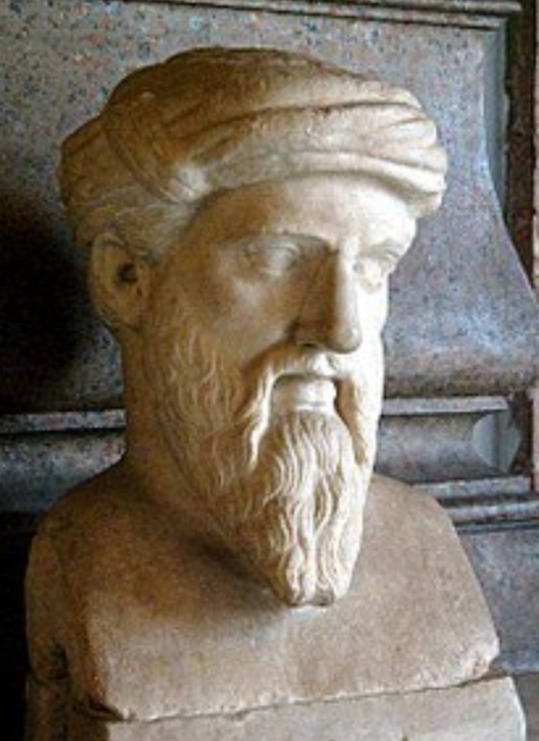
In the next post, I will be talking about ramanujan and shakuntala devi.
Follow me, stay tuned, next post will be uploaded soon.
1 note
·
View note
Note
Hi! You're one of the biggest history buffs I know so I wanted to pick your brain. If you were going to add steampunk and magical/fantasy elements to a time period (any time period in history from around the world) what are your, like, top three picks? I'm incredibly drawn to the Regency Era in England (it's the hopeless romantic in me), but I want to hear your thoughts. :)
Thanks for the question!!
You mean adding magic to our real world historical period, don't you? Not creating a world based on said period and adding magic? I've got to confess I'd never think about this because I always associate magic with imaginary worlds and dimensions, connected or not with ours, more than in our real world, and I haven't read many of this stories, but I'll try.
My top three favorite periods in history are
1. The late Roman Republic. (1st century BC)
2. Alfonso XI kingship and Castillian civil war (XIV century)
3. Bronze age Greece and Asia Minor (II millennium BC)
But i don't know how good those periods would work with magic. Hieron of Alexandria invented the first steam machine in 1st century AD, so you could set the story a little later and do a very alternative steam punk. Also Romans were quite superstitious, and believed in magics like casting courses, astrologist and divinators and also ancient religions offer a space for magic. Etruscan one is particularly fitting for this, because it's very misterious, so there's door for very interesting points there. The other two, I can't imagine right now how it would play out, but I would love anything well researched set on this periods.
Regency England also sounds great to me. But I would be on board with literraly any period, as long as the story is good.
7 notes
·
View notes
Text
The Sanctuary of the Great Gods in Samothrace

The small Greek island of Samothraki in the Aegean Sea was inhabited by Thracians and later by Greeks of Thracian descend. The earliest religious activity on the site dates as early as the 7th century BC but the permanent structures were built in the first half of the 4th century BC and, mainly, in the 3rd century BC, until the early Roman Imperial period.
The island is home to a Pan-Hellenic temple complex called Sanctuary of the Great Gods. The gods worshipped on Samothrace were called "Kabeiroi". The ancient Greek writer Mnaseas names them Axieros, Axiokersa and Axiokersos and says those gods were identified as Demeter, Persephone and Hades respectively. A fourth god, Kathmilos, is mentioned and he is identified as Hermes.
The mystery cult of the Great Mother (Meter Theon Idaia or Mother of the Gods) was at the center of worship here. Many historical figures are said to have been initiated into it. These include the historian Herodotus, the Spartan Lysander and perhaps most famously, Phillip II of Macedonia, the father of Alexander the Great.

The site:
The Temenos This imposing structure had a commanding position on the site and was actually the centre of the cult of the Great Gods. It was the earliest and largest marble building in the sanctuary and its walls were decorated with a frieze bearing the relief representation of dancing girls. Dated to ca. 340 BC. The Hieron It was the second important building of the sanctuary, after the Temenos. It was used for the initiation into the second, higher degree of the Mysteries, called Epopteia. Dated to 325-150 BC The Tholos of Arsinoe It was dedicated to the gods by queen Arsinoe, the wife of king Lysimachos and is the largest circular building known from Greek antiquity. Dated to 288-281 BC. The Propylon of Ptolemy II The monument was offered to the Great Gods by Ptolemy II Philadelphos. Dated between 285 and 281 BC. The Stoa It was built on the west hill, in order to shelter the visitors of the sanctuary. Dated to the first half of the 3rd century BC. The Anaktoron This building was used for initiation into the first degree of the Mysteries, called the Myesis (Initiation). It is dated to the early Roman Imperial period (1st century AD). The Sacred Circle Circular area with five encircling steps on which the spectators stood, watching or participating in the proceedings. Dated to the end of the 5th or the beginning of the 4th century BC. The monument of Nike Rectangular structure facing to the north, where the famous statue of the winged Nike (Victory) of Samothrace stood, attached on a ship's prow (the statue is now exhibited in the Louvre Museum). Dated to the early 2nd century BC.
____________________________________________________________
Sources 1,2,3
#Demeter#Persephone#hades#Greek Mythology#samothrace#aegean#europe#Sanctuary of the Great Gods#ancient greece#archeology#archelogical site#ancient#history#greek gods
14 notes
·
View notes
Text
now that i’m fatt-posting...
i must be missing smth, b/c i tried to tally up the most flirtatious characters in hieron and somehow hadrian beat hella???
hella: 5 (adaire, adelaide, bartender in the bouy, chapter, her best friend)
hadrian: 6 (god i, god ii, god i's boyfriend, god i's boyfriend's servant, his best friend, HIS WIFE)
meanwhile adaire’s always been awkward with everyone but blake and hella, lem fell for like the second(?) npc he met, fero doesn’t flirt as much as acquire and then rebel against parents, throndir is too much of a good boy to do it on-air, fantasmo qbrfa'g rkvfg, and ephrim doesn’t flirt nearly as much as his initial character would suggest
7 notes
·
View notes
Photo

Gospel Reading and Commentary for Monday, January 7, 2019 - Roman Catholic - Matthew 4: 12 - 17, 23 - 25
12. Now when Jesus had heard that John was cast into prison, He departed into Galilee;
13. And leaving Nazareth, He came and dwelt in Capernaum, which is upon the sea coast, in the borders of Zabulon and Nephthalim:
14. That is might be fulfilled which was spoken by Esaeas the prophet, saying,
15. “The land of Zabulon, and the land of Naphthalim, by the way of the sea, beyond Jordan, Galilee of the Gentiles;
16. The people which sat in darkness saw great light; and to them which sat in the region and shadow of death light is sprung up.
Rabanus: Matthew having related the forty days’ fast, the temptation of Christ, and the ministry of Angels, proceeds, “Jesus having heard that John was cast into prison.”
Pseudo-Chrys.: By God without doubt, for none can effect any thing against a holy man, unless God deliver him up. “He withdrew into Galilee,” that is, out of Judaea; both that He might reserve His passion to the fit time, and that He might set us an example of flying from danger.
Chrys.: It is not blameworthy not to throw one’s self into peril, but when one has fallen into it, not to endure manfully. He departed from Judaea both to soften Jewish animosity, and to fulfil a prophecy, seeking moreover to fish for those masters of the world who dwelt in Galilee.
Note also how when He would depart to the Gentiles, He received good cause from the Jews; His forerunner was thrown into prison, which compelled Jesus to pass into Galilee of the Gentiles.
Gloss. ap. Anselm: He came as Luke writes to Nazareth, where He had been brought up, and there entering into the synagogue, He read and spoke many things, for which they sought to throw Him down from the rock, and thence He went to Capernaum; for which Matthew has only, “And leaving the town of Nazareth, He came and dwelt at Capernaum.”
Gloss. ord.: Nazareth is a village in Galilee near Mount Tabor; Capernaum a town in Galilee of the Gentiles near the Lake of Gennesaret; and [p. 131] this is the meaning of the word, “on the sea coast.”
He adds further “in the borders of Zabulon and Naphtali,” where was the first captivity of the Jews by the Assyrians. Thus where the Law was first forgotten, there the Gospel was first preached; and from a place as it were between the two it was spread both to Jews and Gentiles.
Remig.: He left one, viz. Nazareth, that He might enlighten more by His preaching and miracles. Thus leaving an example to all preachers that they should preach at a time and in places where they may do good, to as many as possible. In the prophecy, the words are these - “At that first time the land of Zabulon and the land of Naphtali was lightened, and at the last time was increased the way of the sea beyond Jordan, Galilee of the Gentiles.” [Isa 9:1]
Jerome, Hieron. in Esai. c. 9. 1: They are said at the first time to be lightened from the burden of sin, because in the country of these two tribes, the Saviour first preached the Gospel; “at the last time” their faith “was increased,” most of the Jews remaining in error.
By the sea here is meant the Lake of Gennesaret, a lake formed by the waters of the Jordan, on its shores are the towns of Capernaum, Tiberias, Bethsaida, and Corozaim, in which district principally Christ preached.
Or, according to the interpretation of those Hebrews who believe in Christ, the two tribes Zabulon and Naphtali were taken captive by the Assyrians, and Galilee was left desert; and the prophet therefore says that it was lightened, because it had before suffered the sins of the people; but afterwards the remaining tribes who dwelt beyond Jordan and in Samaria were led into captivity; and Scripture here means that the region which had been the first to suffer captivity, now was the first to see the light of Christ’s preaching.
The Nazarenes again interpret that this was the first part of the country that, on the coming of Christ, was freed from the errors of the Pharisees, and after by the Gospel of the Apostle Paul, the preaching was increased or multiplied throughout all the countries of the Gentiles.
Gloss. ap. Anselm: But Matthew here so quotes the passage as to make them all nominative cases referring to one verb. The land of Zabulon, and the land of Naphtali, which is the way of the sea, and which is beyond Jordan, viz. the people of Galilee of the Gentiles, the people which walked in darkness. [p. 132]
Gloss. ord.: Note that there are two Galilees; one of the Jews, the other of the Gentiles. This division of Galilee had existed from Solomon’s time, who gave twenty cities in Galilee to Hyram, King of Tyre; this part was afterwards called Galilee of the Gentiles; the remained, of the Jews.
Jerome, Hieron.: Or we must read, “beyond Jordan, of Galilee of the Gentiles;” so, I mean, that the people who either sat, or walked in darkness, have seen light, and that not a faint light, as the light of the Prophets, but a great light, as of Him who in the Gospel speaks thus, “I am the light of the world.”
Between death and the shadow of death I suppose this difference; death is said of such as have gone down to the grave with the works of death; the shadow of such as live in sin, and have not yet departed from this world; these may, if they will, yet turn to repentance.
Pseudo-Chrys.: Otherwise, the Gentiles who worshipped idols, and daemons, were they who sat in the region of the shadow of death; the Jews, who did the works of the Law, were in darkness, because the righteousness of God was not yet manifested to them.
Chrys.: But that you may learn that he speaks not of natural day and night, he calls the light, “a great light,” which is in other places called “the true light;” and he adds, “the shadow of death,” to explain what he means by darkness. The words “arose,” and “shined,” shew, that they found it not of their own seeking, but God Himself appeared to them, they did not first run to the light; for men were in the greatest miseries before Christ’s coming; they did not walk but safe in darkness; which was a sign that they hoped for deliverance; for as not knowing what way they should go, shut in by darkness they sat down, having now no power to stand. By darkness he means here, error and ungodliness.
Rabanus, ap. Anselm: In allegory, John and the rest of the Prophets were the voice going before the Word. When prophecy ceased and was fettered, then came the Word, fulfilling what the Prophet had spoken of it, “He departed into Galilee,” i.e. from figure to verity.
Or, into the Church, which is a passing from vice to virtue. Nazareth is interpreted ‘a flower,’ Capernaum, ‘the beautiful village;’ He left therefore the flower of figure, (in which was mystically intended the fruit of the Gospel,) and came [p. 133] into the Church, which was beautiful with Christ’s virtues.
It is “by the sea-coast,” because placed near the waves of this world, it is daily beaten by the storms of persecution.
It is situated between Zabulon and Naphtali, i.e. common to Jews and Gentiles. Zabulon is interpreted, ‘the abode of strength;’ because the Apostles, who were chosen from Judaea, were strong. Nephtali, ‘extension,’ because the Church of the Gentiles was extended through the world.
Aug., de Cons. Evan., ii, 17: John relates in his Gospel the calling of Peter, Andrew, and Nathanael, and the miracle of Cana, before Jesus’ departure into Galilee; all these things the other Evangelists have omitted, carrying on the thread of their narrative with Jesus’ return into Galilee. We must understand then that some days intervened, during which the things took place concerning the calling of the disciples which John relates.
Remig.: But this should be considered with more care, viz. that John says that the Lord went into Galilee, before John the Baptist was thrown into prison. According to John’s Gospel after the water turned into wine, and his going down to Capernaum, and after his going up to Jerusalem, he returned to Judaea and baptized, and John was not yet cast into prison. But here it is after John’s imprisonment that He retires into Galilee, and with this Mark agrees. But we need not suppose any contradiction here. John speaks of the Lord’s first coming into Galilee, which was before the imprisonment of John. He speaks in another place of His second coming into Galilee [John 4:3], and the other Evangelists mention only this second coming into Galilee which was after John’s imprisonment.
Euseb., H. E. iii. 24: It is related that John preached the Gospel almost up to the close of his life without setting forth any thing in writing, and at length came to write for this reason.
The three first written Gospels having come to his knowledge, he confirmed the truth of their history by his own testimony; but there was yet some things wanting, especially an account of what the Lord had done at the first beginning of His preaching. And it is true that the other three Gospels seem to contain only those things which were done in that year in which John the Baptist was put into prison, or executed. For Matthew, after the [p. 134] temptation, proceeds immediately, “Hearing that John was delivered up;” and Mark in like manner. Luke again, even before relating one of Christ’s actions, tells that “Herod had shut up John in prison.” The Apostle John then was requested to put into writing what the preceding Evangelists had left out before the imprisonment of John; hence he says in his Gospel, “this beginning of miracles did Jesus.”
17. From that time Jesus began to preach, and to say, “Repent: for the kingdom of Heaven is at hand.”
Pseudo-Chrys.: Christ’s Gospel should be preached by him who can control his appetites, who contemns the goods of this life, and desires not empty honours. “From this time began Jesus to preach,” that is, after having been tempted, He had overcome hunger in the desert, despised covetousness on the mountain, rejected ambitious desires in the temple.
Or from the time that John was delivered up; for had He begun to preach while John was yet preaching, He would have made John be lightly accounted of, and John’s preaching would have been though superfluous by the side of Christ’s teaching; as when the sun rises at the same time with the morning star, the star’s brightness is hid.
Chrys.: For another cause also He did not preach till John was in prison, that the multitude might not be split into two parties; or as John did no miracle, all men would have been drawn to Christ by His miracles.
Rabanus: In this He further teaches that none should despise the words of a person inferior to Him; as also the Apostle, “If any thing be revealed to him that sits, let the first hold his peace.” [1 Cor 14:30]
Pseudo-Chrys.: He did wisely in making now the beginning of His preaching, that He should not trample upon John’s teaching, but that He might the rather confirm it and demonstrate him to have been a true witness.
Jerome: Shewing also thereby that He was Son of that same God whose prophet John was; and therefore He says, “Repent ye.”
Pseudo-Chrys.: He does not straightway preach righteousness which all knew, but repentance, which all needed. Who then dared to say, ‘I desire to be good, but am not able?” [p. 135]
For repentance corrects the will; and if ye will not repent through fear of evil, at least ye may for the pleasure of good things; hence He says, “the kingdom of heaven is at hand;” that is, the blessings of the heavenly kingdom. As if He has said, Prepare yourselves by repentance, for the time of eternal reward is at hand.
Remig.: And note, He does not say the kingdom of the Canaanite, or the Jebusite, is at hand; the “the kingdom of heaven.” The law promised worldly goods, but the Lord heavenly kingdoms.
Chrys.: Also observe how that in this His first address He says nothing of Himself openly; and that very suitably to the case, for they had yet no right opinion concerning Him. In this commencement moreover He speaks nothing severe, nothing burdensome, as John had concerning the axe laid to the root of the condemned tree, and the lie; but he puts first things merciful, preaching the glad tidings of the kingdom of heaven.
Jerome: Mystically interpreted, Christ begins to preach as soon as John was delivered to prison, because when the Law ceased, the Gospel commenced.
23. And Jesus went about all Galilee, teaching in their synagogues, and preaching the Gospel of [p. 141] the kingdom, and healing all manner of sickness and all manner of disease among the people.
24. And His fame went throughout all Syria: and they brought unto Him all sick people that were taken with divers diseases and torments, and those which were possessed with devils, and those which were lunatic, and those that had the palsy; and He healed them.
25. And there followed Him great multitudes of people from Galilee, and from Decapolis, and from Jerusalem, and from Judaea, and from beyond Jordan.
Pseudo-Chrys.: Kings, when about to go to war with their enemies, first gather an army, and so go out to battle; thus the Lord when about to war against the Devil, first collected Apostles, and then began to preach the Gospel.
Remig.: An example of life for doctors; that they should not be inactive, they are instructed in these words, “And Jesus went about.”
Pseudo-Chrys.: Because they being weak could not come to their physician, He as a zealous Physician went about to visit those who had any grievous sickness. The Lord went round the several regions, and after His example the pastors of each region ought to go round to study the several dispositions of their people, that for the remedy of each disease some medicine may be found in the Church.
Remig.: That they should not be acceptors of persons the preachers are instructed in what follows, “the whole of Galilee.” That they should not go about empty, by the word, “teaching.” That they should seek to benefit not few but many, in what follows, “in their synagogues.”
Chrys.: [ed. note: A passage is here inserted in Nicolai’s edition which is not in the original. It is of no doctrinal importance.] By which too He shewed the Jews that He came not as an enemy of God, or a seducer of souls, but as consenting with his Father.
Remig.: That they should not preach error nor fable, but sound doctrine, is inculcated in the words, “preaching the Gospel of the kingdom.” ‘Teaching’ and ‘preaching’ [p. 142] differ; teaching refers to things present, preaching to things to come; He taught present commandments and preached future promises.
Pseudo-Chrys.: Or, He taught natural righteousness, those things which natural reason teaches, as chastity, humility, and the like, which all men of themselves see to be goods. Such things are necessary to be taught not so much for the sake of making them known as for stirring the heart.
For beneath the prevalence of carnal delights the knowledge of natural righteousness sleeps forgotten. When then a teacher begins to denounce carnal sins, his teaching does not bring up a new knowledge, but recalls to memory one that had been forgotten. But He preached the Gospel, in telling of good things which the ancients had manifestly not heard of, as the happiness of heaven, the resurrection of the dead, and the like.
Or, He taught by interpreting the prophecies concerning Himself; He preached by declaring the benefits that were to come from Himself.
Remig.: That the teacher should study to commend his teaching by his own virtuous conduct is conveyed in those words, “healing every sort of disease and malady among the people;” maladies of the body, diseases of the soul.
Pseudo-Chrys.: Or, by disease we may understand any passion of the mind, as avarice, lust, and such like, by malady unbelief, that is, weakness of faith.
Or, the diseases are the more grievous pains of the body, the maladies the slighter. As He cured the bodily pains by virtue of His divine power, so He cured the spiritual by the word of His mercy.
He first teaches, and then performs the cures, for two reasons. First, that what is needed most may come first; for it is the word of holy instruction, and not miracles, that edify the soul. Secondly, because teaching is commended by miracles, not the converse.
Chrys.: We must consider that when some great change is being wrought, as the introduction of a new polity, God is wont to work miracles, giving pledges of His power to those who are to receive His laws.
Thus when He would make man, He first created a world, and then at length gave man in paradise a law. When He would dispense a law to the holy Noah, he shewed truly great wonders; and again when He was about to ordain the Law for the Jews, He first shewed great prodigies, and then at [p. 143] length gave them the commandments. So now when about to introduce a sublime discipline of life, He first provided a sanction to His instructions by mighty signs, because the eternal kingdom He preached was not seen, by the things which did appear, He made sure that which as yet did not appear.
Gloss. ap. Anselm: Because preachers should have good testimony from those who are without, lest if their life is open to censure, their preaching be contemned, he adds, “And the fame of him went abroad through all Syria.”
Rabanus: Syria here is all the region from Euphrates to the Great sea, from Cappodocia to Egypt, in which is the country of Palestine, inhabited by Jews.
Chrys.: Observe the reserve of the Evangelist; he does not give an account of any one of the various cases of healing, but passes in one brief phrase an abundance of miracles, “they brought to him all their sick.”
Remig.: By these he would have us understand various but slighter diseases; but when he says, “seized with divers sicknesses and torments,” he would have those understood, of whom it is subjoined, “and who had daemons.”
Gloss: ‘Sickness’ means a lasting ailment; ‘torment’ is an acute pain, as pleurisy, and such like; they “who had daemons” are they who were tormented by the daemons.
Remig.: ‘Lunatics’ are so called from the moon; for as it waxes in its monthly seasons they are tormented.
Jerome: Not really smitten by the moon, but who were believed to be so through the subtlety of the daemons, who by observing the seasons of the moon, sought to bring an evil report against the creature, that is might redound to the blasphemy of the Creator.
Aug., City of God, book 21, ch. 6: Daemons are enticed to take up their abode in many creatures, (created not by themselves but God,) by delights adapted to their various natures; not that they are animals, drawn by meats; but spirits attracted by signs which agree with each one’s taste.
Rabanus: Paralytics are those whose bodies have their nerves slackened or resolved from a Greek word, signifying this.
Pseudo-Chrys.: In some places it is, “He cured many;” but here, “He cured them,” meaning, ‘all;’ as a new physician first entering a town cures all who come to him to beget a good opinion concerning himself.
Chrys.: He requires no direct profession of faith from them, both because He had not yet given them any proofs of His miraculous [p. 144] power, and because in bringing their sick from far they had shewn no small faith.
Rabanus: The crowds that followed Him consisted of four sorts of men. Some followed for the heavenly teaching as disciples, some for the curing of their diseases, some from the reports concerning Him alone, and curiosity to find whether they were true; others from envy, wishing to catch Him in some matter that they might accuse Him.
Mystically, Syria is interpreted ‘lofty,’ Galilee, ‘turning:’ or ‘a wheel;’ that is, the Devil and the world; the Devil is both proud and always turned round to the bottom; the world in which the fame of Christ went abroad through preaching: the daemoniacs are the idolaters; the lunatics, the unstable; the paralytics, the slow and careless.
Gloss. ap. Anselm: The crowds that follow the Lord, are they of the Church, which is spiritually designated by Galilee, passing to virtuousness; Decapolis is he who keeps the Ten Commandments; Jerusalem and Judaea, he who is enlightened by the vision of peace and confession; and beyond Jordan, he who having passed the waters of Baptism enters the land of promise.
Remig.: Or, they follow the Lord “from Galilee,” that is, from the unstable world; from Decapolis, (the country of ten towns,) signifying those who break the Ten Commandments; “and from Jerusalem,” because before it was preserved unhurt in peace; “and from Jordan,” that is, from the confession of the Devil; “and from beyond Jordan,” they who were first planted in paganism, but passing the water of Baptism came to Christ.
1 note
·
View note
Photo
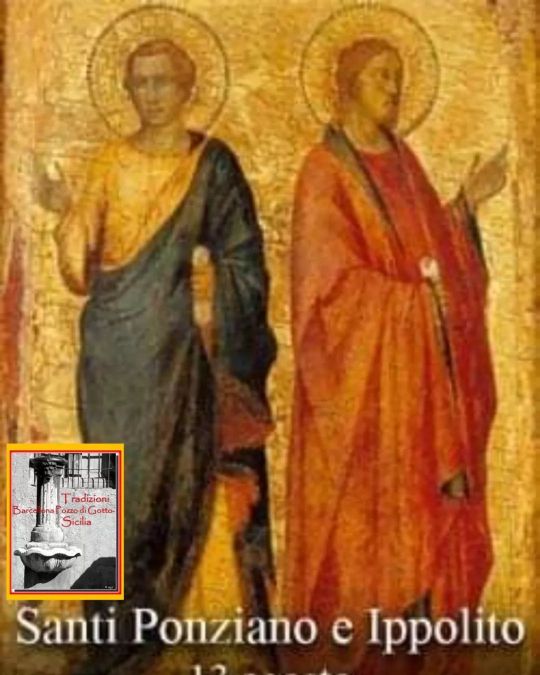
SABATO 13 AGOSTO 2022 - ♦️ SANTI PONZIANO E IPPOLITO ♦️ Ponziano (Roma, ... – Sardegna, 19 novembre 235) è stato il 18º vescovo di Roma e papa della Chiesa cattolica, che lo venera come santo. Fu papa dal 21 luglio 230 al 28 settembre 235 nonché il secondo ad abdicare dopo Clemente I. La sua data di nascita è ignota. Secondo il Liber Pontificalis nacque a Roma e suo padre si chiamava Calpurnio. Con Ponziano inizia la breve cronaca dei vescovi di Roma del III secolo, della quale l'autore del Catalogo Liberiano dei papi fece uso nel IV secolo, che contiene dati più veritieri sulle vite dei pontefici. Secondo questa fonte Ponziano fu eletto papa il 21 luglio 230 e regnò fino al 235. Lo scisma di Ippolito di Roma continuò anche durante il suo episcopato, ma, verso la fine del suo regno, ci fu una riconciliazione tra la parte scismatica ed il vescovo di Roma. Dopo la condanna di Origene Adamantio ad Alessandria d'Egitto (231-232), convocò a Roma un altro sinodo che, secondo Girolamo (Epistole XXXII, 4) e Rufino (Apol. contra Hieron., II, 20), confermò le decisioni del Sinodo alessandrino. Dopo anni di tranquillità per la comunità cristiana, nel 235, durante il regno di Massimino il Trace, iniziò una persecuzione diretta principalmente contro i capi della Chiesa. Una delle sue prime vittime fu Ponziano che fu deportato insieme ad Ippolito in Sardegna (ad metalla), secondo un'antica tradizione ancora attestata nel XVI secolo, nell'isola di Tavolara (Insula ... Tegularia dicta, sancti Pontiani pontificis exilio et morte clara). Per rendere possibile l'elezione di un nuovo papa, Ponziano si dimise il 28 settembre del 235 (il Catalogo Liberiano usava le parole discinctus est).[1][3] Dopo papa Clemente I, quello di Ponziano fu dunque il secondo caso di un papa dimissionario. Al suo posto fu eletto papa Antero. Poco prima di questo avvenimento o immediatamente dopo, Ippolito, che era stato deportato in Sardegna con Ponziano, si riconciliò con la Chiesa di Roma e lo scisma causato ebbe termine. Secondo il Liber Pontificalis, il papa morì a causa delle privazioni e del trattamento disumano che dovette subire, circa un mese dopo l'abdicazione; per quanto tempo ancora Ponziano (presso Tradizioni Barcellona Pozzo di Gotto - Sicilia) https://www.instagram.com/p/ChM3ITmMNoB/?igshid=NGJjMDIxMWI=
0 notes
Photo
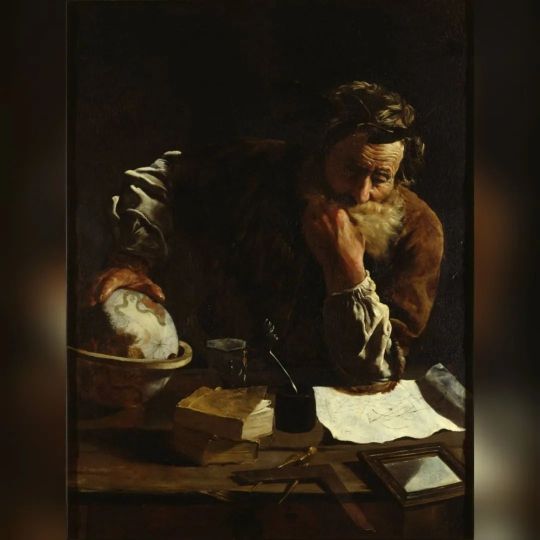
Archimedes (287–212 BC) was a Greek physicist, mathematician and inventor. The "Spiral of Archimedes" and the "Lever" are some of his inventions. He developed the idea of "specific gravity", called "Archimedes' Principle". Archimedes was born in the Greek colony of Syracuse, Sicily, around 287 BC. C., Son of Phidias, a Greek astronomer, who used to gather in his house the elite of philosophers and men of science, to exchange ideas about their works. At that time, Hieron II reigned, who had a certain degree of kinship with the family of Archimedes. Archimedes studied at the Alexandrian School of Mathematics, which at the time was the intellectual center of the Greek world. He had contact with the most advanced science of his time, living with great mathematicians and astronomers, including Eratosthenes of Cyrene, the mathematician who first calculated the circumference of the earth. https://www.instagram.com/p/CeMjGu-jNCf/?igshid=NGJjMDIxMWI=
0 notes
Photo

Herbal Medicine Recipes for Kidney Inflammation Disease
Treatment of inflammatory diseases of the kidneys or urinary tract uses medicinal plants that have anti-inflammatory (anti-inflammatory), fever-reducing (antipyretic) effects, pain relievers (analgesic), and germ killer (antibiotics).
Recipe I
Prepare 15 g dry or 40 g fresh sambiloto (Andrographis paniculata) plant, 10 g dry or 30 g fresh cakar ayam (Selaginella doederleinii Hieron) leaves, 10 g dry or 30 g fresh meniran (Phyllanthus urinaria) plant, and 10 g dry or 30 g fresh cat whiskers/kumis kucing (Orthosiphon aristatus) leaves.
Wash all ingredients, poach in a liter of water.
After remaining half, remove, strain.
Drink in the morning, afternoon, and evening.
Once drink 150 ml.
Recipe II
Prepare 20 g of dry or 50 g of fresh turmeric (Curcuma longa), 15 g of dry alang-alang (Imperata cylindrica) roots, 10 g of dry or 30 g of fresh daun sendok (Plantago major), and 10 g of dry or 30 g of fresh tapak liman (Elephantopus scaber) plant.
Wash all ingredients, poach in a liter of water.
After remaining half, remove, strain.
Drink in the morning, afternoon, and evening.
Once drink 150 ml.
Recipe III
Prepare 15 g dry or 40 g fresh sambiloto (Andrographis paniculata) plant, 10 g dry brotowali/heart-leaved moonseed (Tinospora cordifolia), 15 g dry or 40 g fresh gotu kola,pegagan (Centella asiatica) plant, and 10 g dry or 30 g fresh cat whiskers/kumis kucing (Orthosiphon aristatus) plant.
Wash all ingredients, poach in a liter of water.
After remaining half, remove, strain.
Drink three times a day, in the morning, afternoon, and evening.
Once drink 150 ml.
Recipe IV
Prepare 10 g dry or 30 g fresh rumput mutiara (Oldenlandia corymbosa) plant, 10 g dry or 30 g fresh cakar ayam (Selaginella doederleinii Hieron) plant, 10 g dry or 30 g fresh purslane/krokot (Portulaca oleracea) plant, and 10 g dry or 30 g fresh tapak liman (Elephantopus scaber) plant plant.
Wash all ingredients, poach in a liter of water.
After remaining half, remove, strain.
Drink three times a day, in the morning, afternoon, and evening.
Once drink 150 ml.
Recipe V
Prepare 10 g of dry or 30 g of fresh meniran (Phyllanthus urinaria) plant, 20 g of dry alang-alang (Imperata cylindrica) roots, 20 g of dry temulawak (Curcuma zanthorrhiza) rhizome, 10 g of dry or 30 g of fresh sambiloto (Andrographis paniculata) plant, and 15 g of fresh tamarind/asam jawa (Tamarindus indica).
Wash all ingredients, poach in a liter of water.
After remaining half, remove, strain.
Drink three times a day, in the morning, afternoon, and evening.
Once drink 150 ml.
Recipe VI
Prepare 10 g dry or 30 g fresh turmeric (Curcuma longa), 10 g dry or 30 g fresh daun sendok (Plantago major), 30 g dry bark of frangipani (Plumeria), and 40 g fresh corn silk.
Wash all ingredients, poach in a liter of water.
After remaining half, remove, strain.
Drink three times a day, in the morning, afternoon,and evening.
Once drink 150 ml.
Suggestions during the healing period of inflammatory kidney disease by using herbal medicine
Get enough rest
Drink at least two liters of water a day
Avoid soda, coffee and tea
https://english.tajba.com/herbal-medicine-recipes-for-kidney-inflammation-disease/
0 notes
Photo
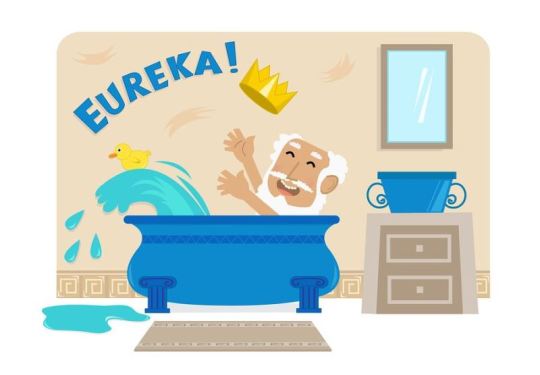
How Archimedes’ Principle Was Discovered
The story behind the discovery of Archimedes’ principle is pretty interesting. Late in the first century, The king of Syracuse ‘Hieron II’ called ‘Archimedes’ to check the purity of his new crown without causing any damage to it. He wanted to know that whether his new crown was of pure gold or not? Archimedes thought for a long time to find out the method of checking the purity of the king’s crown, but he couldn’t find it. Later, one day, when he went for the bath, and he entered the bathtub, he noticed that the weight of the water displaced by his body was equal to that of his own body weight. By using this principle, he found the method to check the purity of the crown. He knew that the gold was heavier than the other metals that the goldsmith might have had used as the substituents in the crown. By immersing the crown and a pure gold piece of the same mass as that of the crown in the water, he found that the density of the crown was less than the density of the pure gold piece as the crown displaced more water than the pure gold, hence the crown was not of pure gold. In the excitement of finding this method, he ran naked to the king, shouting “Eureka!,” which means “I have found it.” So in this way, the “Eureka” moment led to the discovery of Archimedes’ principle. This story was written by a Roman architect, ‘Vitruvius.’
0 notes
Text
Thinking either Ancient Sicilian Pirate for Michele as well or one of the Ancient Greek rulers of Syracuse, like Hieron II. The latter of course would have the opportunity for a charming followup illustration where Harry carries Michele, boasting: "Hey you losers, I kidnapped your king! So you better do as I say if you want him back!" Just some time travel faux-kidnapping romance.
#Harry puts out impossible but also ... odd demands so nothing that actually strains the economy or whatever#so that he can have time to go off and canoodle with Michele without actually causing a war#I had too many things with time travel lately that I do not understand so I am not even gonna attempt to unravel this#beablabbers#sicire#storie nostre#aph
3 notes
·
View notes